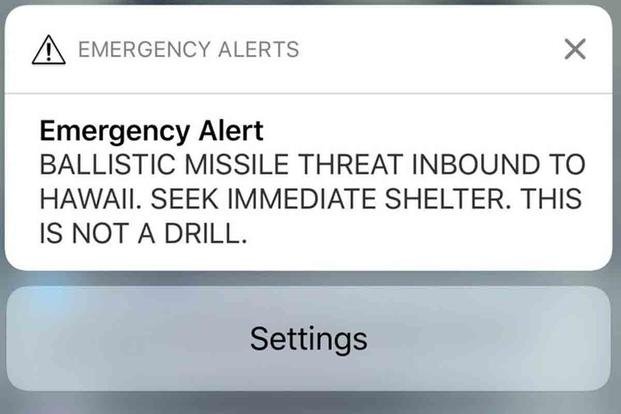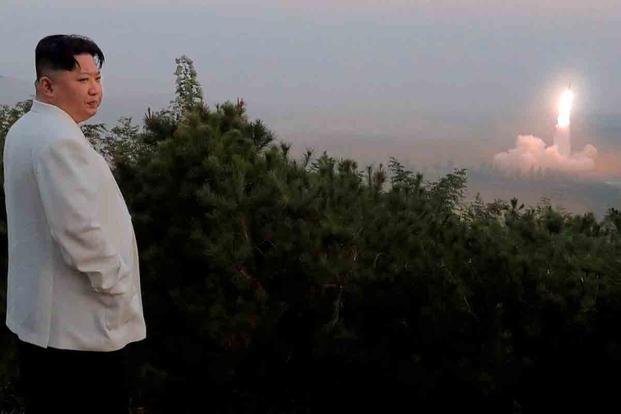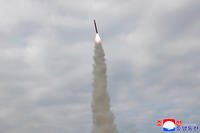It might be hard for many mainlanders to remember, given every historical event that has occurred since 2017, but Hawaiians and visitors to the island in January 2018 will probably never forget the time they prepared for nuclear destruction. At least, they thought they were preparing for nuclear destruction, which is something most Americans haven't had to do since the end of the Cold War, if at all.
At a time when North Korea was surprisingly belligerent toward its foes (and even its friend) and President Donald Trump was willing to respond "with fire, fury and frankly power, the likes of which the world has never seen before," the world looked like it was facing a new Cuban Missile Crisis -- and Hawaii was literally caught in the middle.
On Jan. 13, 2018, Hawaiians got a rude awakening. Just after 8 a.m., mobile phones across the state sounded the alarm: A ballistic missile was on its way to Hawaii. The people knew it wasn't a drill because the emergency alert clearly said, in all caps: "THIS IS NOT A DRILL."

One year prior, North Korean dictator Kim Jong Un had announced his country was preparing the test of its first intercontinental ballistic missile, one that was capable of reaching the mainland United States. If it could hit Los Angeles, then it could certainly strike Honolulu. With characteristic belligerence, Kim criticized its chief ally, China, and denounced the United States in the same speech.
After slapping North Korea with some more sanctions, the U.S. ramped up its efforts to install Terminal High Altitude Area Defense (THAAD) anti-ballistic missile defenses in South Korea. It also sent a carrier strike group led by the USS Carl Vinson to the western Pacific. Trump announced the United States was prepared to end North Korea's threat unilaterally, if necessary.
Then, the war of words began. Trump threatened to meet North Korean aggression with fire and fury via Twitter. North Korea responded by threatening to fire four missiles at the U.S. territory of Guam. Trump announced the U.S. military was "locked and loaded," waiting for Kim to move, as Kim waited for Trump's next move. North Korea tested its missiles ( though not toward Guam) while the United States and South Korea conducted its regular joint exercises, preparing for a war with North Korea.
At the UN General Assembly in September 2017, Trump told the world the U.S. was totally prepared to destroy "Rocket Man" Kim and his country. Kim responded by calling Trump a "mentally deranged U.S. dotard." It was an exchange that would have been ridiculous had the two men not had ICBMs waiting to fire. Trump re-listed North Korea as a state sponsor of terrorism. North Korea fired more missiles.
Then, on the morning of Jan. 13, 2018, smartphones in Hawaii started lighting up across the islands with the warning, "Ballistic Missile Threat Inbound to Hawaii. Seek Immediate Shelter. This is not a drill." Broadcast radio and television feeds interrupted programs with an audio recording:
"The U.S. Pacific Command has detected a missile threat to Hawaii. A missile may impact on land or sea within minutes. This is not a drill. If you are indoors, stay indoors. If you are outdoors, seek immediate shelter in a building. Remain indoors well away from windows. If you are driving, pull safely to the side of the road and seek shelter in a building or lay on the floor. We will announce when the threat has ended. This is not a drill. Take immediate action measures."
Adjutant General Arthur "Joe" Logan of the Hawaii National Guard called Pacific Command and discovered no inbound missile was within minutes of the alert. Further alerts were canceled. Official social media channels let residents know it was a false alarm. Thirty-eight minutes later, a second alert was sent to smartphones in Hawaii: "There is no missile threat or danger to the State of Hawaii. Repeat. False Alarm."
During those 38 minutes, people not watching television and not looking on social media, citizens were preparing for the worst. Hawaiians went running for cover, either to fallout shelters or concrete bunkers (if they knew where to find them). Drivers on the freeway were speeding toward the relative safety of non-urban areas. Phone lines and wireless carriers were overwhelmed by frightened Hawaiians looking for information. Some even said a heartfelt goodbye to their loved ones.
North Korea called the incident a "tragicomedy."
It turns out that one employee at Hawaii's Emergency Management Agency was confused by an unscheduled drill during a shift change. The employee, who was never named, had reportedly confused drills with real-world events before in his 10 years working for the agency. Vern T. Miyagi, head of the Hawaii EMA, would also resign.
The long-term result of the incident was the Federal Communications Commission's implementation of procedures that would make it more difficult to issue a false alarm. The agency also reportedly developed more geographically precise alert systems that can be restricted to fractions of a mile, rather than alerting an entire state or country -- although it's not clear how fractions of a mile could help those in a nuclear war, real or accidentally imagined.
-- Blake Stilwell can be reached at blake.stilwell@military.com. He can also be found on Facebook, X or on LinkedIn.
Want to Learn More About Military Life?
Whether you're thinking of joining the military, looking for post-military careers or keeping up with military life and benefits, Military.com has you covered. Subscribe to Military.com to have military news, updates and resources delivered directly to your inbox.
















